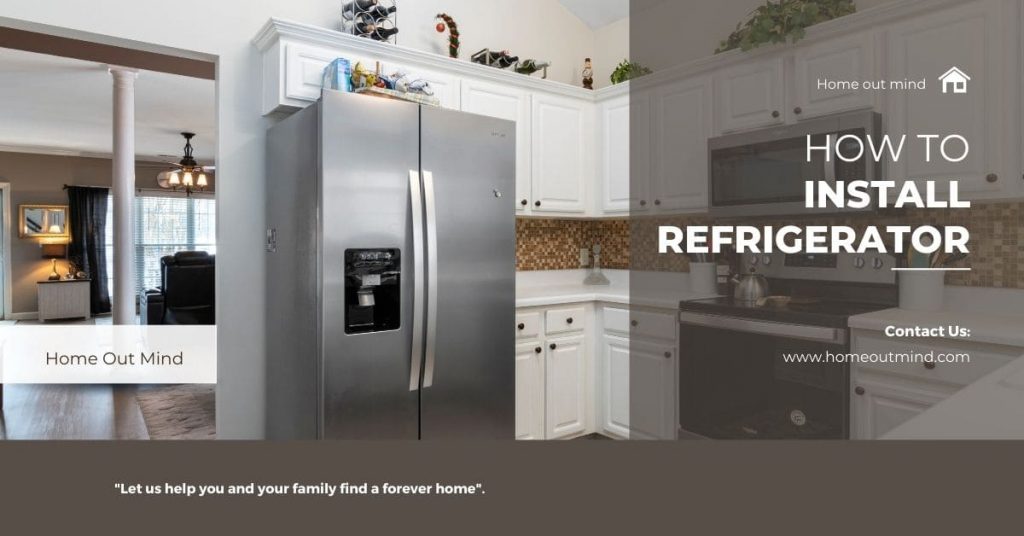Are you wondering how to install refrigerator? Is this the first time you try to install a refrigerator? do you find it difficult to install a new refrigerator? You’re in the right place where we’ll show you how to install refrigerator step-by-step.
After you’ve bought your refrigerator you ask yourself may now install the fridge to yourself or call a professional which costs you extra money so please read the steps and instructions below henceforward you’ll install the refrigerator alone without calling a professional.

Before you start:
Once you get the refrigerator unpack your fridge from the box.
Tools you will need:
- Phillips screwdriver
- Flat-head screwdriver
- Socket spanner
- Allen spanner
- Parts and tools required
- Water line fixer and screws
- Coupler
- Water line
- Water filter lock-clip
- Water filter
- Check valve
How to install refrigerator Step-By-Step
Step1. Select a site
Site requirements:
• Solid, level surface without carpeting or flooring that may obstruct ventilation
• Away from direct sunlight
• Adequate room for opening and closing the door
• Away from a heat source
• Room for maintenance and servicing
• Temperature range: between 5 °C and 43 °C
To ensure proper ventilation for your refrigerator:
- allow for ¹⁄₂” (1.27 cm) of space on each side and at the top.
- Allow for 1″ (2.54 cm) of space behind the refrigerator.
If your refrigerator has an ice maker, allow extra space at the back for the water line connections. When installing your refrigerator next to a fixed wall,
- leave a 2″ (5.08 cm) minimum space on each side (depending on your model) to allow the doors to swing open.
Step2. Spacing
1. Open the door and locate the provided spacer.
2. Unpack the spacer and attach it to the rear of the refrigerator. It helps ventilate air to the rear wall and save power consumption.
• The surface to install the refrigerator must support a fully loaded refrigerator.
• To protect the floor, put a large piece of cardboard on each leg of the refrigerator.
• Once the refrigerator is in its final position, do not move it unless necessary to protect the floor. If you have to, use thick paper or cloth such as old carpets along the movement path.
Step4. Adjust the levelling feet
The refrigerator can be leveled using the front legs that have a special screw (leveler) for leveling purposes.
Use a flat-head screwdriver for leveling.
To adjust the height of the freezer side:
- insert a flat-head screwdriver into the leveller of the freezer-side front leg.
- Turn the leveller clockwise to raise, or turn it counter clockwise to lower.
To adjust the height of the fridge side:
- Insert a flat-head screwdriver into the leveller of the fridge-side front leg.
- Turn the leveller clockwise to raise, or turn it counter clockwise to lower.
Step5. Adjust the door height as well as the door gap
To adjust the height of a door:
The refrigerator must be leveled on a flat, solid floor. Failing to do so can cause damage to the refrigerator or physical injury.
Leveling must be performed with an empty refrigerator.
Make sure no food items remain inside the refrigerator. For safety reasons, adjust the front side a little higher than the rear side.
The height of a door can be adjusted using the clamp nut and the height nut on the front bottom of each door.
1. Open the door to adjust, and locate the two nuts on the front bottom of the door.
2. With a spanner turn the clamp nut clockwise to loosen. Then, open the door, and do the following inside the door.
- To raise the door, turn the height nut counter clockwise.
- To lower the door, turn the height nut clockwise.
3. When complete, tighten the clamp nut by turning it counterclockwise.
Step6. Connect the water dispenser line
- Parts and tools required
- Water line fixer and screws
- Coupler
- Water line
- Water filter lock-clip
- Water filter
- Check valve
Installation (external dispenser line)
1. Assemble the water pipeline using couplers.
2. Close the main water supply, and then close the water tap.
3. Connect the coupler to the cold water tap.
Make sure you connect the coupler to the cold water tap. Connection to the hot water tap may cause the water filter to be clogged and fail to operate normally.
Step8. Connect to a water source
To connect the cold water pipe to the water filtering hose:
Make sure the water filtering hose is connected to a cold, potable water source pipe. Connecting to the hot water pipe may cause the water filter to malfunction.
1. Shut off the water supply by closing the main water valve.
2. Locate the cold, potable water pipe.
3. Follow the Water Line Installation to connect to the water pipe.
NOTE: New hose-sets supplied with the appliance are to be used and old hose-sets should not be reused.
To connect the water filtering hose to the water line
1. Loosen and remove the compression nut from the waterline of the refrigerator, and insert it into the water filtering hose.
2. Tighten up the compression nut to connect the water filtering hose and the waterline.
3. Open the main water valve and check for any leaks.
4. If there are no leaks, dispense about 10 liters of water or dispense the water for 6 – 7 minutes before actually using the refrigerator to remove impurities inside the water filtering system.
5. Secure the water line to a sink or a wall using a clip.
- Do not tighten the water line excessively. Make sure the water line is not bent, pinched, or squashed.
- Do not mount the water line on any part of the refrigerator. This may damage the refrigerator.
Note: If you have to relocate the refrigerator after connecting the waterline, make sure the joined section of the water line must is straight.
Reverse osmosis water filtration system
The water pressure of the water supply system to a reverse osmosis water filtration system must be between 206 kPa (30 psi) and 861 kPa (125 psi).
The water pressure of the reverse osmosis water filtration system to the refrigerator’s cold water line must be at least 206 kPa (30 psi). If the water pressure is below the specified:
• Check if the sediment filter in the reverse osmosis system is blocked. Replace the filter if necessary.
• Refill the water tank in the reverse osmosis system with water.
• If your refrigerator has a water filter, it may further reduce the water pressure when used in conjunction with a reverse osmosis system. Remove the water filter.
To mount the water filter into place:
1. Attach the lock clips (x2) to appropriate positions under the sink, for instance. Then, fix the lock clips firmly using screws.
2. Insert the water filter into the upper and lower clips in the correct direction. Make sure to check the vertical direction of the water filter.
If the filter is installed horizontally, water may remain in the filter. Therefore, vertical installation is recommended.
Do not mount the water filter on any part of the refrigerator. This may damage the refrigerator.
STEP8. Initial settings
By completing the following steps, the refrigerator should be fully functioning.
1. Plug the power cord into the wall socket to turn the refrigerator on.
2. Open the door, and check if the interior light lights up.
3. Set the temperature to the coldest, and wait for about an hour. Then, the freezer will be slightly chilled, and the motor will run smoothly.
4. Wait until the refrigerator reaches the set temperature. Now the refrigerator is ready for use.
Step9. Final check
When the installation is complete, confirm that:
• The refrigerator is plugged into an electrical outlet and grounded properly.
• The refrigerator is installed on a flat, level surface with a reasonable clearance from the wall or the cabinet.
• The refrigerator is level and is sitting firmly on the floor.
• The door opens and closes freely, and the interior light turns on automatically when you open the door.
Step10. Door removal for entrance
If the refrigerator cannot pass through the entrance due to its size, follow these instructions:
Tools required:
These tools are used for removing the doors.
- Phillips screwdriver
- Flat-head screwdriver
- Socket spanner
- Allen spanner
Disconnect the water line
- From the bottom rear side of the refrigerator, pull out the water line to the front.
- 2. To disconnect the hoses, press and hold the transparent coupler and detach the water hose.
NOTE: The refrigerator’s water line is a water circulation line that connects between the water pipe from the water source and the hoses from the water filtering system of the refrigerator.
Do not apply excessive force to the coupler. It may break.
Detach the doors
1. Use a Phillips screwdriver to unscrew the hinge covers on the top of each door.
2. Open the doors to loosen the hinges and remove the hinge covers. Once the covers are removed, close the doors.
3. Disconnect the electrical harness.
4. Unscrew the hinge screws counterclockwise, and remove the upper hinge. Be careful as the door can fall on you, causing physical injury.
5. Remove the hinges on both sides.
6. Gently lift up the doors one by one to remove them. Use caution as the door may fall off or over.
Reconnect the water hoses
Once the refrigerator has passed through the entrance, reconnect the water hoses.
- Make sure the water hoses are connected with matching colours.
- To prevent water leaks, each water hose must be inserted fully to the centre of the transparent coupler.
- After reconnecting the water hoses, push them under the cabinet and arrange them on the hook.
Reattach the doors
Before reattaching the doors, make sure all the electrical connectors are properly connected.
The freezer door must be reattached before the fridge door.
1. Hold the freezer door and hook to the hinge at the bottom of the refrigerator.
2. On the top side, insert the hinge into the hinge slot.
3. Insert the upper hinge shaft into the hinge hole. Make sure the hinge shaft is straight so that all screw holes are fully revealed. Then, tighten the hinge screws clockwise.
4. Connect the electrical harness.
5. Insert the hinge covers with the front sides first, and then tighten the screws. Use a Phillips screwdriver for this step.
Read also:
- Why does my refrigerator leak water?
- How to change air filter in LG refrigerator?
- How to clean refrigerator water filter?
- How to remove Samsung refrigerator doors?
- How to clean condenser coils on ge profile refrigerator?
Step11. Install door handles
PARTS INCLUDED: Door handles (2), ¹⁄₈” hex key, spare setscrew(s) To Install the Handles:
NOTE: The handle mounting setscrews are preinstalled in the handle.
1. Remove the handles, which are packed inside the refrigerator.
NOTE: To avoid scratching the finish, place the handles on a towel or other soft surface.
2. Open the freezer door. On the refrigerator door, place the handle on the shoulder screws with the setscrews facing the freezer.
3. Firmly push the handle toward the door until the handle base is flush against the door.
4. While holding the handle, insert the short end of the hex key into the upper hole and slightly rotate the hex key until it is engaged in the setscrew.
5. Using a clockwise motion, tighten the setscrew until it begins to contact the shoulder screw.
6. Repeat steps 4 and 5 to begin fastening the lower set screw.
7. Once both setscrews have been partially tightened as outlined in the previous steps, fully tighten both the upper and lower setscrews.
IMPORTANT: When the screws feel tight, tighten them an additional quarter-turn. The handle is not properly installed without this extra tightening.
8. Open the refrigerator door and close the freezer door. Repeat steps 2 through 7 to install the other handle onto the freezer door with the setscrews facing the refrigerator.
9. Save the hex key and all instructions.




